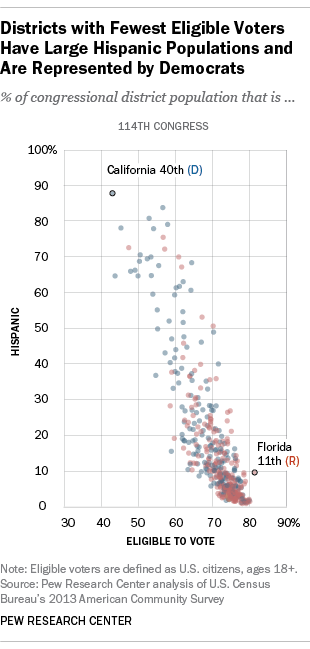Of the 25 districts with the highest Hispanic population shares, 19 also are among the 25 districts with the lowest eligible-voter share. This is because so many Hispanics aren’t eligible to vote, either because they’re not U.S. citizens or because they’re younger than 18. By our calculations, only about 45% of the nation’s nearly 54 million Hispanics are eligible to vote.
Now look at this visual representation:
And now this:
There also are clear partisan differences between districts with high and low shares of eligible voters. Of the 35 districts where less than 60% of the population are voting-age citizens, 29 are held by Democrats; Democrats represent 19 of the lowest-ranking 20. On the other end, Republicans represent 31 of the 42 districts where 77% or more of the population are voting-age citizens, and 16 of the highest 20.
Most of this is probably fairly logical: the Hispanic population is young, and not often legal U.S. citizens. So while we think they have a lot of emergent political power — minorities will be the majority by 2050, largely thanks to Hispanics — there are still opportunities for that to shift.
Here’s one: Evenwel vs. Abbott, coming down the pike soon with a decision likely expected in 2016. At question is a bedrock principle of the American political/legal system: “one person, one vote.” If the Supreme Court agrees with the two Texas voters (no question it was going to originate in Texas…) who brought the case, there could be a power shift towards Republicans.
Here’s the essence of why, from The New York Times:
A ruling that districts must be based on equal numbers of voters would move political power away from cities, with their many immigrants and children, and toward older and more homogeneous rural areas.
Technically it should be noted that Evenwel vs. Abbott is only set up to apply to state/local, but it’s likely that whatever the ruling might carry over to Congressional districts.
In 2001, the Supreme Court heard a similar case, and shot it down. Clarence Thomas objected, writing this:
“We have never determined the relevant ‘population’ that states and localities must equally distribute among their districts,” he wrote.
“The one-person-one-vote principle may, in the end, be of little consequence if we decide that each jurisdiction can choose its own measure of population,” Justice Thomas added. “But as long as we sustain the one-person-one-vote principle, we have an obligation to explain to states and localities what it actually means.”
The connection — however tenuous at times — between the Republican party and the Hispanic voting block is a huge issue of late, with Jeb Bush’s wife (who is Hispanic) becoming a potential focal point of his campaign, and Marco Rubio (who is Hispanic) courting issues like poverty and student loans as a way to connect his “base” with his “people.”
Now it seems we might be turning to the legal system as a way to suss this out. Something to keep an eye on, no?


